Tediously transcribed from a PDF issue of the San Joaquin Historian
Leslie Crow
Fall 1994 issue of The San Joaquin Historian
This is devoted to the history of the various business enterprises of the Wagner family and how they have contributed to the economic vitality of our county. From the first, the members of this family have been identified as solid citizens and wise and capable business leaders. Fellow countrymen of Stockton's founder, Charles M. Weber, the Wagners were leaders in business from the arrival of the first member of the family. Weber himself sold Jacob Wagner the land which became the site of the Pacific Tannery. Today the Pacific Storage Company is still located on part of that original block.
Many changes have occurred on the block bounded by EI Dorado, Oak, Hunter and Fremont streets. However, the building on Oak Street, which dates from the 1870s and once housed the tannery's machine works, remains and has been designated a City of Stockton Landmark.
In 1928, just before the Great Depression began, the tanning business was no longer profitable. The Wagners ceased the production of leather products which had begun in 1856 and closed their operation. In 1932, Charles C, Edward H. and Edward C. Wagner formed the company called the Pacific Storage Company for the purpose of general warehousing and storage of commodities. That same year, they became agents for the Bekins Moving and Storage Company.
German immigrants Jacob and Charles Wagner, brothers from Wurtemberg, founded a business in Stockton in 1856 which played a significant role in the economic development of our community. The Wagners had been lured to California by the news of the discovery of gold, but had found out that the hard work and the lack of regular pay days was not a secure way to make a living. As had so many other would-be millionaires in California, they settled down in a central location and began to ply the trade with which they were familiar. The Wagner brothers had learned to be tanners from their father, who had owned a tannery and trained his sons in the skills necessary to produce high quality leather goods.
For many years the Pacific Tannery was located at the head of McLeod Lake at El Dorado and Oak Streets. Hides and tan bark extract were shipped through the San Joaquin Delta, up the Stockton Channel and into McLeod Lake where a drawbridge over EI Dorado Street could be moved to provide access directly into the tannery. Shipments of finished goods reversed the course and were sent across the nation and overseas.
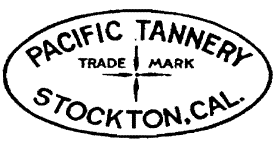
However, by 1931, local newspapers carried the announcement that many items which the Wagner Leather Company had used in their tannery business were for sale. Motors, tanks, fans, hand trucks, auto trucks and trailers were offered. It was "The Great Depression," thebottom had fallen out of the leather trade some years previously and the family business, begun in 1856 and passed on from father to son, could not hold on any longer. In June, 1928, the decision was made to liquidate the company's assets. It took until December of that year to complete the processing and shipment of the leather products on hand.
In 1932, articles of incorporation were filed for the Pacific Storage Company, initially capitalized at $25,000. The former Wagner Leather Company warehouses, with a capacity of 25,000 square feet, were to be used to store grain and other commodities. The promise of prosperity was on the horizon as Federal approvals for the development of the deep water channel had been secured and the City of Stockton was poised to become an international seaport by 1933. Edward Wagner stated at the time that lithe deep water project will bring the local markets closer to the world markets" and that he had "absolute confidence in the success of the project.”
The story begins
Wagner family enterprises in Stockton were begun by Jacob C. Wagner who had arrived in California from his native Germany in 1852 in search of gold. He soon determined that high quality leather goods were in demand in the Central Valley. He had been trained as a tanner by his father in Germany and felt his skills would provide him with a better, more secure way to make a living than the hard work of prospecting for gold.
It must be remembered that leather goods were not just desirable luxuries; they were necessities in nineteenth century California. The need for harness, tack, boots and shoes was critical to the economy. Without leather harness, bridles and saddles, men and goods could not be transported to and from the southern mines.
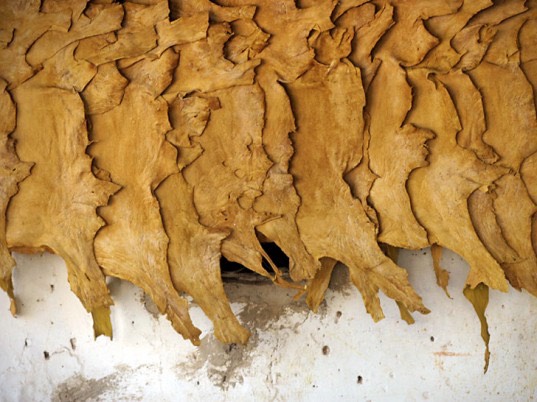
"Hides formed one of the principal products shipped from this valley in the early days, and it was not long before the fact was recognized that more money could be made by converting them into leather here, than in shipping them to eastern towns, and then be compelled to buy the leather from them. The first tannery was established in 1853, by J. C. Wagner, which has since been developed into the large establishment, the Pacific Tannery, Kullman, Wagner & Co., proprietors."
Jacob C. Wagner, a native of Wurtemberg, Germany, was the son of Christian and Johnanna (Gunsser) Wagner. Christian Wagner owned a local tannery. Christian's father, John, was a brewer, but had been in charge of his father's tannery in Balingen. Jacob was drawn to California by news of the discovery of gold in 1852.
He continued mining in the southern part of the state, until convinced that more dependable and satisfactory returns would be enjoyed by following his trade. Though the tanner's trade was less romantic, there was no element of chance about it, and the times and conditions made it necessary for him to have a dependable income.
By 1858 there were five tanneries in Stockton. "The operations of the several establishments are not steady and uniform, but depend much upon the demand for the manufactured article. Many of those engaged in the business have other occupations.“ Graham & Steward were located about a mile away from town on the north bank of the main channel. Others were H. R. Potter, Mr. Steiner and a "French establishment" on Mormon slough, which tanned 1,200 sheep skins annually. Jacob Wagner's tannery was established on north EI Dorado street.
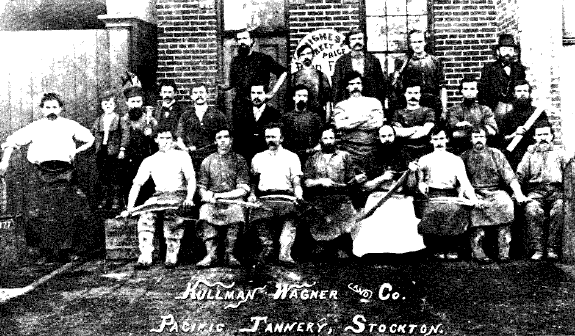
The Kullman, Wagner & Co. employees posed in front of the Pacific Tannery in 1877.
Tan bark was transported by boat to the Pacific Tannery from coastal oak forests. The local oak trees produced tannic acid in significantly lower concentrations than the Chestnut oaks along the coast. Oak trees were stripped of their bark in large strips, which rolled naturally as they dried. The bark was ground into chips and the tannins leached out of it for use in the tanning process.
"Most of the leather sent to this State is manufactured from hides obtained from South America. In this vicinity, for sole leather, the hides of Spanish cattle being stout and compact. are used, while saddle, harness and upper leather, is mostly manufactured from American hides. Most of the material is obtained from the slaughter houses in this city and vicinity."
The five tanneries combined were estimated to have processed from ten to twelve thousand hides each year. These tanneries used only locally procured tan bark from a region within a few miles of town, costing from ten to fifteen dollars per cord.
By 1862 there were two tanneries mentioned in Stockton newspapers; Jacob Wagner's on the north side of McLeod Lake and Kraig's on Mormon slough. They each employed only about four to six men. The tanning process used at the time was detailed in an article in the Daily San Joaquin Republican:
"It takes from six to seven months to tan sole leather and skirting (for saddles) from four to five months; calf and kip skins are tanned in from thirty to forty days. Alarge number of sheep pelts and furred peltries--such as coon, wildcat, coyote, fox, wolf, goat, and other skins are tanned and prepared for different saddle, and upholstery uses and ornaments. During the past year, the work has been delayed by the floods, yet the vats have turned out 1,500 hides to tanned leather, for harness, sole and saddle work, and over 800 skins. Mr. Wagner is now using Santa Cruz chestnut-oak tan bark which will enable him to compete with the Santa Cruz tanneries. This bark makes the very best harness, sole and hose leather in the market, which sells faster than it can be tanned and finished."
The Chestnut oak could be processed into a solution higher in tannic acid than the Spanish oak and twice as much as the local Live oak. Additional tan bark sources were developed along the Northern coast of California and shipped to Stockton. By using this superior tan bark, the Pacific Tannery was able to employ forty-five men, tanning 1,500 hides a month by 1880.
The Pacific Tannery was started in "that part of Stockton [that] was practically in the wilderness, although it was in the limits of the city and the country roundabout was used principally for vegetable farms which were worked by Italians." Jacob Wagner started his tannery on the bank of the Stockton channel, in "an old shed beneath an oak tree." His "tanbark was ground by an old horse in a tread mill." From this inauspicious beginning, the block bounded by El Dorado, Oak, Fremont and Hunter Streets, at the head of McLeod Lake would eventually be completely occupied by the Pacific Tannery.
Charles Wagner joins his brother
Jacob's brother, Charles, was born on January 23, 1837. Charles followed his brother to California in the fall of 1855. He traveled on the ship Bavaria from Havre, France to New York. He then boarded the steamer Northern Light for Chagres, Panama, crossed the isthmus by mule, then sailed on to San Francisco by steamer. He arrived on January 19, 1856 and passed through Stockton on his way to a location near Copperopolis in Calaveras County, where he tried his luck in the gold fields. After only a month, he gave up his search for gold and returned to Stockton where he joined his brother.
In order to increase his knowledge about the latest methods in the tanning trade, Charles went to Santa Cruz in 1859. Santa Cruz was the production center for the highest quality leather goods being produced in the north state at the time. Wagner worked on the coast for two years before returning to Stockton. In 1865, Jacob and Charles formally organized their business as the Wagner Brothers.
Charles Wagner married Philippina Simon in 1867. She had been born in 1846 in Bosenback, Bavaria, the daughter of Jacob and Katrina (Rothenbush) Simon. They had two children, Edward Charles, born on November 24, 1869, and Bertha Emily (Mrs. George E. Housken), born July 23, 1873. Edward Charles would later become vice-president of the Wagner Leather Company, and still later succeed his father as president of the business. George Housken would become the company's secretary.
Charles Wagner was a charter member of the Turn-Verein Society, a group of German immigrants, and was the only charter member still alive in 1906 when the group celebrated their 50th anniversary. He was also a charter member of the Stockton Lodge No. 11 of the Independent Order of Odd Fellows.
The business grows
In 1869 Moses Kullman, a fellow German who had come to Stockton in 1853, became a financial partner in the business which became known as Kullman, Wagner & Company. Kullman had been operating a cigar store at the corner of Weber avenue and EI Dorado street, but sold out to become a partner in the business. They were able to expand their property holdings and increase their capacity with this infusion of capital. In 1870, Kullman's brother, Herman, joined the partnership and four years later Jacob Salz, a friend of Kullman who was a merchant in Centerville, also became financially involved.
A survey of the 1870 Stockton City Directory discloses that there were around twenty men who identified themselves as tanners living in the city. Employees at the Pacific Tannery noted were: Julius Breith, Moses Kullmann, John Tamelty, Charles Wagner, J. C. Wagner and Jacob Ziegler. Charles Hart was employed as a clerk with M. Kullman.
The Pacific Tannery was one of four tanneries listed in 1870; the others were the Stockton Tannery, run by J. S. Derby on Scott Avenue between Hunter and EI Dorado, Frank Seilnacht's tannery on Scott Avenue between Center and Commerce, and T. H. Woods' tannery on San Joaquin between Jefferson and Jackson.
The Pacific Tannery buildings located on the block bounded by El Dorado, Oak, Hunter and Fremont streets experienced serious fires in 1867, 1871 and again in 1875.
On August 21, 1867, fire destroyed most of the tannery, believed to have been caused by sparks from the engine room smoke stack falling onto the roof. Losses were estimated to have been in the amount of $10,000. "With the enterprise characteristic of the firm, they never stopped their tanning operations, but cleared away the debris and immediately commenced the erection of a new building, which is rapidly approaching completion." The new equipment included a twenty horsepower steam engine manufactured at the Globe Foundry which "worked as smooth as clock-work." This engine provided power to the rolling machines, the bark mill, the pumps which transferred liquids to and from the vats, as well as supplying the steam to boil the bark and dry the tanned leather.
The company recycled their solutions by pumping the "weakened liquid" into a cistern to be strengthened by having more tan bark added before being reused.
Twelve to fifteen men were employed producing 150 hides per week in 1867. Hides came from San Francisco slaughter houses. "The reputation that the Messrs. Wagner have established for producing a superior article of leather has created an extensive demand for their manufactures, and large shipments are made to New york nearly every month, where the article is in good repute."
The fire of September, 1871 caused the tannery to deepen the McLeod Lake access to the plant "to a depth sufficient to permit vessels to float close up to the shed and there discharge cargoes of bark, thus avoiding the expense of repeated handling." An inclined plane was constructed which allowed a car to be pulled along a track to the second floor by machinery attached to the bark grinding mill. This allowed the tan bark to be transported overhead so that it could be dropped into the mill grinders more easily. "The mill grinds about ten cords of bark per day, and requires a man constantly in attendance to feed it. The bark bin in the upper story, is heated by steam pipes, for the purpose of drying the bark before it is ground." The tan bark storage building was enlarged from 50 x 100 feet to 100 square feet. About thirty men were employed at this time.
Hides and tan bark were transported to the Pacific Tannery via McLeod Lake through the El Dorado Street drawbridge. Photo courtesy Bank of Stoclcton Photo Collection.
On March 1, 1875, Stocktonians awoke to learn that the Pacific Tannery had caught fire between ten and eleven o'clock the night before. The City Hall bell had sounded the alarm, sending the Weber and San Joaquin Engine Companies to respond. The building was fully involved in flames when the fire fighters arrived, but they managed to save "the books, papers and money in the office.”
Losses were realized to buildings, stock and machinery in the amount of $75,000 to $100,000. This was the third disastrous fire experienced by the company in a short period of time. The Stockton Daily Independent stated that “Its destruction was a public calamity."
After the 1875 fire, the buildings were reconstructed of brick. "Brick and iron structures took the place of former frame buildings and were provided with the latest and best machinery and appliances." These new buildings were designed by local architect Charles Beasley. James T. Edwards & Son was the brick contractor and James A. Brown the carpentry contractor. The building was not completed until late in June. One hundred tan-pits were on the site. Twenty-five men were employed, with the expectation that there would soon be a considerable increase in the work force.
Economic decline impacts the tanning trade
"One of the most important and prosperous industries in Stockton is the manufacture of leather, for which those engaged in the business find a ready sale in distant markets. The quality of the leather produced in this city is not surpassed, if it is equaled on the Pacific coast.
In its statistical exhibit for the past year, the Commercial Herald says that the leather market during the past year suffered unexampled depression, and tanners have been subjected to a greater strain than any that has occurred since 1868..."
In spite of this down-tum in leather exports at a critical time in the company's history, the Pacific Tannery survived both the calamity of the destruction of their facility by fire in 1875 and the economic slump of 1876.
Death of a business partner
On November 6, 1878 Moses Kullman died suddenly in San Francisco. Initial reports stated that mends and associates in Stockton were astonished by the news. Kullman had come to Stockton from Gennany in 1853 and had subsequently started his own business, selling cigars. After selling out his interests, he became a partner with the Wagner Brothers in 1869. He had been representing the firm in Francisco since 1874. "He was very much esteemed as an upright and energetic business man as well as a genial and popular member of society."
Kullman was about 45 years of age and unmarried, although engaged to Sarah Kallisher, daughter of E. D. Kallisher, formerly of Stockton.
Evening papers from San Francisco on November 7 brought the news that Kullman had, in fact, committed suicide. "The cause that is now attributed is the relations that he is known to have sustained toward a woman who, it is supposed, would have made life intolerable to him after the consummation of his marriage with his affianced." The San Francisco Chronicle gave the following account of the incident:
"At 2 o'clock yesterday morning Moses Kullman, a native of Germany, aged 45 years, and a member of the firm of Kullman, Wagner & Co. Clay street, committed suicide by shooting himself in the heart atthe Howard House corner of Stockton and O'Farrel streets. The occupants of the rooms adjoining heard the shot, followed by groans. Officer Duncan was summoned, and breaking in the door found the deceased, fully dressed, lying dead upon the bed, with a revolver beside him. Upon him were found five letters, sealed, directed to Nathan Mayor, H. Kullman and Sarah Kallisher, city, and Jacob Herman Kullman, Salz and Charles Hart, Stockton. Herman Kullman, brother of the deceased, says that he saw him on Tuesday afternoon between two and three o'clock, when he complained of feeling unwell, and said he was going home. Deceased was engaged to a young lady of this city, and the marriage was to have come off this week. In the letter to his brother the deceased said: 'It is terrible to be compelled to inflict such pain on you, but it was impossible to prevent the same. When a person cannot eat or sleep, as has been the case with me for a number of days past, you can easily imagine that life has no charm for me. Sarah, as well as the entire Kallisher family, I feel extremely sorry for, and hope you will do your utmost to console them.'
The contents of Kullman's will were disclosed in the San Francisco Call on November 11, 1878. His estate was valued at $25,000. Those named in his will were "Barbeth Hart, widow, Frederika Marks, Rachael Salz, Amelia Rosenbaum, Fannie Hart, Henrietta Hart, Carrie Hart Henrietta Marks and Charles Wagner of Stockton, Mary Loudman of New York, Louis Kullman and Herman Kullman of San Francisco.”
Business continues to grow; a founder dies
By 1879, the tannery was making large purchases of hides, pelts, goat skins and tallow. They sold the finished leather goods throughout California, Oregon, New York and Boston, as well as shipping their products to Japan. In 1890, the firm expended over $250,000 for raw materials and employed between fifty and seventy-five men.
Jacob C. Wagner, the founder of the Pacific Tannery, died at the age of 69 years on October 24, 1896. The business which he had begun with his brother in 1856 had been prosperous for forty years. He left a wife, two daughters and his brother. Daughter Emily taught at the Lafayette School and her students prepared remembrances for her father. At his gravesite in the Stockton Rural Cemetery, Reverend Daniel G. Mackinnon of St. John's Episcopal church officiated. "The grave in Rural cemetery was lined with white muslin and the box was covered with the same material, and all the earth around was covered and hidden by flowers so completely thatthere was no suggestion of the cold earth."
The business had continued to operate under the name of Kullman, Wagner & Company until 1895 when it was incorporated as the Wagner Leather Company, "a name which has gained high prestige for upright dealing and honest goods."
Sixty men were employed at the Pacific Tannery in 1897, producing 36,000 hides annually, valued at $180,000. The annual payroll was $45,000. The company was selling to wholesalers nationwide. Train cars of leather products were shipped to the East coast for assembly into shoes and harnesses.
In 1909 the Wagner Leather Company was described again in glowing terms:
"This is the only manufacturing plant of the kind in the San Joaquin valley and it therefore draws its patronage from a wide field. The corporation has other outside interests, the principal one being an extract factory in Humboldt county, where a supply of the California oak tan bark is yet abundant; the juice is extracted, evaporated and shipped to the tannery in barrels.”
Tan bark production
Sources of tan bark were becoming scarcer and scarcer in the immediate area at the turn of the century and the Wagner Leather and Tanning Company built a bark extracting plant near Briceland in Humboldt County in 1903. The tannery planned to ship the curing extract made from the tan bark to Stockton from nearby Shelter Cove. Wagner's operation was the largest undertaken in Humboldt County, even though that area's tanneries had been in business since about 1890. Tan bark was peeled in the spring and summer months. The Wagners employed up to five hundred local men during the peak years of their operation. The first electric lights in southern Humboldt County were at the tan bark processing center developed by the Wagner Company. Each year during the height of production, over 3,000 cords of tan bark were processed into $100,000 worth of extract.
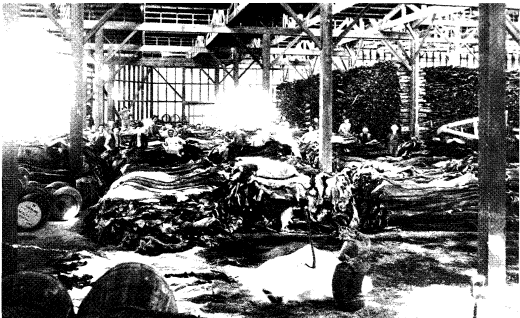
By 1897, the Pacific Tannery processed up to 36,000 hides valued at $180,000 annually. The company employed sixty men and was selling to wholesalers nationwide and overseas.
Tan oak trees could be peeled only during a short season each year, usually between May 15 and July 15. First the bark was scored with an axe as closely to the ground as possible, then again four feet up the trunk. A vertical cut was made between the two cuts and the bark peeled and stripped off the trunk. The tree was then felled with an axe or a cross cut saw and the rest of the bark peeled off the tree in four foot sections. Some of the largest limbs were also stripped of their bark. The trees were peeled and the bark left on the ground to naturally dry into tightly rolled strips so that it would be lighter when it was ready to be loaded and hauled for processing.
The bark was taken to the processing plant by pack mules and placed on sleds which were hauled by horses to the mill where it was ground into small pieces. Then the bark was leached in water to extract the tannin. This solution was boiled until reduced to a syrupy consistency and poured into fifty gallon barrels. These barrels were loaded onto wagons with six horse teams to move them to Shelter Cove, ready to be loaded on board ships headed for Stockton.
Shelter Cove was considered to be the best harbor on the California coast between San Francisco and Eureka. A long, eight hundred foot wharf was built to accommodate the steamships which called at the harbor. The port facilities were sold in 1902 to the Wagner Leather Company and the Bowden Brothers who owned the general store and hotel nearby. It was during this period, until 1925 when the Wagner Leather Company sold out their interests in Humboldt County, that Shelter Cove was known as "Stockton Harbor."

These large vats were
used to soak the
hides for extended
periods; six to seven
months for
sole
leather and skirting
for
saddles
was
typical. Calf skins
took thirty to forty
days. Sheep pelts,
wildcat, fox, wolf,
goat and other skins
were also processed
for use as ornamental
upholstry.
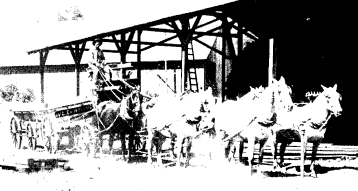
In 1903, the Wagner Leather Company established a tan bark production plant in Humboldt County. It was here that up to 500 men were employed during the tan bark peeling season. The tan bark was peeled from the oak trees, left to dry, then loaded onto wagons to be hauled to the processing plant in Briceland. The bark was ground and then soaked in water to extract the tannins. This solution was boiled down and concentrated for shipment in barrels from Shelter Cove. During this period, Sheller Cove was called "Stockton Harbor."
FIRE, again
In July, 1918, yet another fire devastated the facility on EI Dorado Street and Oak Streets. "Every available engine in the city, including the Sperry Flour company's" was engaged in fighting the fire. Samuel Kahn, general manager of the Western States Gas & Electric Company, was passing the tannery at the time the fire started. He was able to call his office and had the gas and electricity cut off to the entire city north of Main Street in order to safe guard the lives of the fire fighters. Only one week earlier, Alexander Vint had been killed in such an accident while fighting another fire.
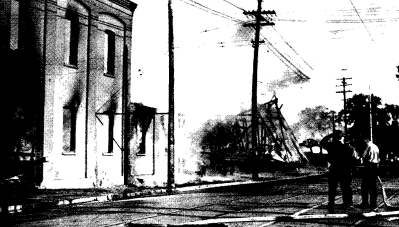
On July 14, 1918, the Pacific Tannery caught fire about 5:30 pm in the drying loft where the leather was hung to dry. It spread quickly, involving the entire plant. Every available fire engine in the city, as well as the Sperry Flour Company's crew, was sent to fight the blaze.
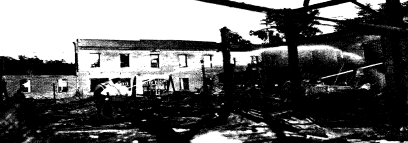
Several fire fighters and tannery employees were injured when one of the walls of the burning building collapsed. When the fire was at it height, the heat was so intense that it was nearly impossible to be on the El Dorado street side of the structure.
Fire department personnel were injured while attacking the blaze, including Ralph Thompson who was burned by carbolic acid when a barrel exploded. J. T. Simpson and A. Denser were injured when a wall caved in. Wagner Company employee William J. Ziegler "was severely injured in the heroic effort to prevent the firemen and other volunteers entering a dangerous section of the burning building and in an attempt to protect the company's tanning liquors by the closing of certain valves." Ziegler's long association with the Volunteer Fire Department doubtless played a role in his heroism.
Ziegler's injuries ultimately led to his retirement in March, 1920 after 52 years with the tannery. "In appreciation of his long years of faithfulness, the management of the Wagner Leather company ... awarded Mr. Ziegler a monthly pension ... "
Ziegler was born on May 15, 1853 in Wudenberg, Germany. His father, John Jacob Ziegler, relocated the family to California after hearing about the discovery of gold. They came by ship, travelling "around the Horn" and landing in San Francisco. They first moved to the Jamestown area and settled near Sullivan Creek. Ziegler was able to make a living by gold mining, but decided that the family should move to Stockton where he could once again work as a tanner.
In 1868 the Zieglers moved into a home on East Aurora Street, between Sonora and Church Streets, later the site of what would become the Holt Manufacturing Company. Both of John Jacob's two sons, August and William, were also employed by the Pacific Tannery. August did not work at the tannery as long as William due to ill health. He married and went into farming.
However, William J. Ziegler spent the rest of his life as an employee of the Pacific Tannery, with the exception of a few years spent at work in a Santa Cruz tannery. He worked his way through many jobs at the tannery "until he became general foreman of the plant ... closest to his heart, next to his family, came the tannery. There was never a time in his life when he was needed that he was not willing to perform his duty willingly."
On March 17, 1920, Ziegler's wife of thirty-five years, Elizabeth (Charters), died. This loss, along with his poor health, led to his demise on July 19, 1920 in Santa Cruz. The couple had five children: Fred, Lottie, Oscar William, Amy (Mrs. Arthur C. Hannigan) and Edna (Mrs. Clinton E. Spencer).
At Ziegler's death, the flags at the Wagner Leather company flew at half mast out of respect for their loyal employee.
Edward Charles Wagner joins the firm
Edward Charles Wagner was born in Stockton on November 24, 1869, the son of Charles and Philippina Wagner. When he finished his schooling in the Stockton public schools, he was enrolled in a local business college. He was admitted into the family tanning business at the age of seventeen, but was required to work his way up through all of the departments.
"He worked with the tan bark, in the engine room, and pipe and carpenter work. and finally passed on to the more technical parts of the tanner's trade. Young Wagner was fortunate in that he was placed among elderly men, who, appreciating his desire to learn, were helpful to him and imparted all the knowledge at their disposal. It did not nmatter what the task might be or how long the hours of labor. the young man stuck to it and never passed from one department to another until his knowledge was complete.”
Edward C. Wagner married Nellie Hellwig, daughter of a prominent tanner in San Francisco, in 1900. They became the parents of Edward H. and Charles C. Wagner.
Edward H. Wagner became the vice-president of the Wagner Leather Company and later succeeded his father as president. In time, he also served as the vice-president of the Pacific Storage Company.
His brother, Charles C. Wagner, served as the president and manager of the storage operation.
Edward C. Wagner, accompanied by his wife, was sent on a good-will tour of the Orient in 1921 by the San Francisco Chamber of Commerce. Indeed, Wagner became very well travelled on behalf of the tanning business. His interest in the export end of the business was evident and he was described as a "wise adviser and capable leader."
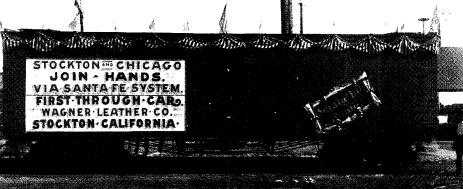
The Wagner Leather Company shipped an entire railroad car of leather goods to Chicago by way of the
Santa Fe Railroad circa 1890.
In 1922, Edward C. Wagner was appointed to the board of managers of the San Joaquin Valley Agricultural Association by Governor William D. Stephens. He was also a member of the Native Sons of the Golden West and the San Joaquin Pioneer and Historical Society. He died in February, 1940, at the age of 70.
The leather industry was still in a strong position in the Stockton economy in 1923.
"Pure tanned California oak scoured sole leather, in hard and pliable tannage, is a special feature of their output, great quantities of this valuable product being produced and exported to the world's market. The company ranks today as one of the greatest of western leather manufacturing and distributing organizations, and is a prominent factor in the industrial life of Stockton. The demand for the Stockton product from all parts of the civilized world is one of the big development factors of this section of California, and to properly care for the increasing sole-leather trade a general branch office and sales department are maintained in San Francisco, whence the export trade is handled."
Storm clouds on the horizon
Edward H. Wagner entered the family business after attending the Pratt Institute of Technology in New York where he majored in chemical engineering. He was able, for the first time, to establish some laboratory controls for the tanning process which up until this time had been governed by knowledge gained only by experience and some rudimentary testing using a thermometer and hydrometer to determine the density of the solutions.
A reduction in sales to Asian countries was being experienced due to several factors. The Japanese, in particular, instituted an import duty which reduced the profitability of doing business in their country. They were also beginning to start tanning facilities in their own country to reduce the import costs of leather products.
In addition, freighting charges became so high that it was not profitable to send leather goods by rail to the shoe manufacturing plants in the Eastern United States.
These factors taken together caused the Wagner Leather Company to take stock. They were unable to compete in the marketplace under the existing circumstances. The Wagner family knew that their location in the heart of Stockton's downtown was no longer desirable to the growing community. Offensive odors are produced in thetanning process; today they might be labeled an ecological hazard. The Wagner Leather Company purchased land along the Stockton Deep Water Channel with the intention of relocating their plant out of the civic center area. The move was never made as the tannery ceased operation at the end of 1928.
A new idea
The end of the tannery business was just the beginning of the enterprise which we know today as the Pacific Storage Company. In order to continue to utilize the space once occupied by their tanning business, and with a view toward the future prosperity of Stockton based on the opening of the Deep Water Channel, the Wagner family converted their business interests into commodity storage.
Articles of Incorporation were filed and certified by Frank C. Jordan, Secretary of State of the State of California on July 14, 1932 establishing the Pacific Storage Company "to conduct and carry on the business of general warehousing in all its several branches ... " Three directors were named: Charles C. Wagner, Edward H. Wagner and Edward C. Wagner, all residing in Stockton, California. Two hundred and fifty shares of stock valued at $100 each were issued, with an aggregate par value of all shares equalling $25,000.
The Pacific Storage Company became agents for the Bekins Moving and Storage Company.
Articles of incorporation filed on August 13, 1936 changed the name of the firm from the Wagner Leather Company to the Wagner Corporation. "The name Wagner Corporation was adopted as more fitting for disposal of real estate possessed." Directors of the company were Ed C. Wagner, Mrs. G. E. Housken, Mrs. Nellie Wagner, Clarence Keister, Edward H. Wagner, Charles C. Wagner and Tito Bertilacchi.
In December, 1940, the building at the corner of Hunter and Fremont Streets which had been built after the fire of 1918, was remodelled. The red brick warehouse was converted "into an imposing cream-hued commercial building, with spaces for six stores or offices on the ground floor. The Wagner Corporation and the Pacific Storage Company have made an expenditure of $20,000 to effect the transformation.“ Hoefler's Creamery and Coffee Shop, the Stockton Acceptance Corporation and the Pacific Storage Company were all housed in the building. Pacific Storage used the top three floors for their storage facility in addition to locating their offices in the northeast corner of the structure.
President of the Pacific Storage Company, Charles C. Wagner, stated "that the reason the building has so many upper floor windows is that my grandfather, Charles Wagner ... envisioned its future use as an office building or apartment house."
Charles Christian Wagner II was one of the founders of the Pacific Storage Company and served as the Chief Executive Officer of the Wagner Corporation, a real estate and timber company. Wagner was a pioneer in tree breeding research in Humboldt County in conjunction with the University of California at Berkeley. He served on the Save the Redwoods League board and was the founding director of Forest Land Owners of California. He was named the California Tree Farmer of the Year in 1977.
He was a graduate of Stanford University, who also earned a Master's of Business Administration at that institution. In addition to his duties with Pacific Storage Company, he was a former president of the California Moving and Storage Association and the National Furniture Warehouseman Association. He also raised and sold purebred cattle in Linden and was a founding director of the California Beef Cattle Association.
Wagner was married to Leona W. Wagner, the father of Charles W. and Nancy Lynne (Forster). He was the grandfather to four grand-daughters and two great grand-daughters. He died at the age of 86 in 1992.
Charles W. Wagner and his sister, Nancy Forster have both served in various capacities in the company. Charles and his wife, Gail, have four daughters: Lisa, Wendy, Beth and Katie.
The Bekins Company, a brief history
The Bekins Company has an interesting history of its own. Sjoerd Bekius migrated to the United States from Holland, settling in Michigan where he fathered thirteen children. In 1880, while still a teenager, Sjoerd's son, Martin, simplified his name to Bekins and moved to Grand Rapids where he landed a job driving freight wagons. He was soon joined by his brother, John.
The Bekins brothers decided to start their own company in 1891. They founded the Bekins Van and Storage Lines in Sioux City, Iowa. They placed brothers Dan and Taeke in charge of the business and went to Omaha, Nebraska where they once again opened a moving and storage company. In 1895, they also located a similar business on the West Coast in Los Angeles and "organized the first transcontinental move from Sioux City to Los Angeles."
The Bekins brothers were able to bring innovation to the moving and storing business by specializing in moving household goods and implementing containerized storage. The Bekins company was also among the first to employ motorized trucks in the moving business, beginning in 1903. Two trucks which used two-cylinder, air-cooled engines were used; one in Los Angeles, and one in San Francisco. By the end of World War I, the company no longer used any horse drawn conveyances.
In 1918, Milo W. Bekins, Sr., Reed, Floyd and Ruth Bekins purchased the company's California interests from their father. Milo Bekins became the chairman of the Bekins company in 1927. In 1928 the first transcontinental motor van trip was arranged from Sioux City, Iowa to Los Angeles. The company was centered in Nebraska for a time before moving their headquarters to Salt Lake City. By 1947, the prevailing trends in the moving business caused them to again relocate to Chicago. By the 1950s, the Bekins company was serving the entire nation, helping to move the many families relocating after World War II.
In 1956, the ownership structure of the Bekins Van Lines Company was transferred to the California company with an exchange of stock with the various individual owners. By September, 1963, Bekins operated 90 warehouses, and employed 3,000 people at that time.
A holding company was established known as The Bekins Company, on January 1, 1969. This body was responsible for administration of all company policy and oversight of financial affairs. This centralization allowed the company to diversify and enter into other fields.
Flexible pricing and other changes in the moving business were allowed after the lifting of stringent government regulation of the moving industry when the Household Goods Transportation Act of 1980 was passed by Congress.
In 1991, the Bekins Company celebrated its 100th anniversary.
Today Irwin L. Jacobs is the Chairman of the Board of The Bekins Company and Andrew E. Estoclet is President and Chief Executive Officer of The Bekins Company and Bekins Van Lines.
Mr. Jacobs is a partner and substantial investor in the IMR Fund, L. P. of Minneapolis, Minnesota, which owns a significant, controlling interest in The Bekins Company. Robert E. Wheaton is the President and Chief Executive Officer of Bekins Moving and Storage Group.
Looking Ahead
In 1964, Robert W. Foy, a native of San Francisco, joined Pacific Storage Company. A 1959 graduate of San Jose State University, he earned a Bachelor of Science degree in Business and Industrial Management. He has held the position of president of the company since 1977.
Today the finn is one of the oldest and largest Bekins Moving and Storage agents in the United States. With offices in Stockton, San Jose, Sacramento and Modesto, the finn mainly moves and stores household goods, business records and provides commercial transportation and warehousing. Their annual sales are in excess of five million dollars.
Foy and his wife, Barbara (Barron) have two sons, Matthew and Peter, both born in Stockton. The Foy family is extremely supportive of the community and active In many organizations.
Conclusion
The Wagner family has always found success in business through the course of 138 years. From the beginning, they have met market demand, provided excellence to their customers and loyalty to their dedicated employees. The tannery gave way to a moving and storage business which met the needs of the post-World War II period when families began to relocate from coast to coast.
While the days of shipping hides through McLeod Lake for processing into finished leather goods did not survive the Depression, the spirit of enterprise has continued from 1856 to 1994. The Stockton Daily Independent predicted as early as 1867 that enterprises such as the Pacific Tannery provided a luster to Stockton's commercial community. It was the Wagner brothers' vision and devotion to quality goods which caused them to be exemplary.
"It is through such enterprise in manufacturers that a country is built up and made wealthy. When similar manufacturing industries in other branches of art and mechanics are established in this city, Stockton will have made an advance in the right direction to become a place ofmore than local importance."
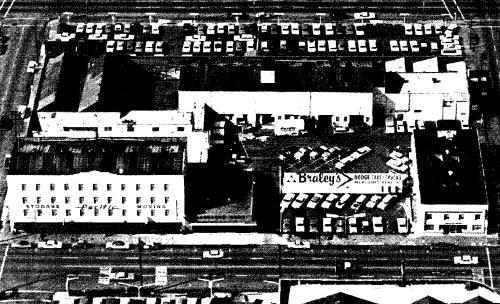
The Pacific Storage Company is shown in this 1966 aerial view.
Photos courtesy Bank of Stockton Photo Collection. http://www.sanjoaquinhistory.org/documents/HistorianNS3-1.pdf
Back to the Tannery Archive Return to Top
Begun January 2016